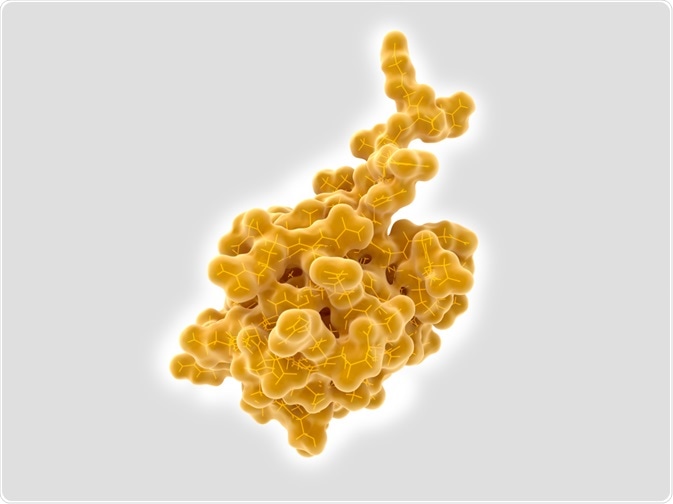Ubiquitin is a protein that is present throughout cellular tissues in eukaryotic organisms which plays a regulatory role in the processes of other proteins and is a versatile molecular signal.
First discovered in 1975, the most recognizable role it plays in cells is in apoptosis, but it is also involved in several different cellular functions such as immune function and gene transcription.

Image Credit: Juan Gaertner/Shutterstock.com
Ubiquitin has been highly conserved through eukaryotic evolution: Human and yeast ubiquitin share a 96% sequence identity. Ubiquitin is not found in prokaryotic organisms, though there are homologs present in these organisms.
It is present throughout cells in the nucleus, cytoplasm, and cell-surface membrane. The process by which ubiquitin binds to a substrate protein is known as ubiquitination or ubiquitylation.
The enzymes which seem to be critical determinants in substate selection and are important components of ubiquitin chain formation on a substrate are the Ubiquitin ligases.
Structure of Ubiquitin
Ubiquitin consists of 76 amino acids and its molecular mass is about 8.6KDa. The structure of ubiquitin comprises a compact β-grasp fold. It also has a flexible C-terminal tail with 6 residues, and a core which contains rigid residues.
The most important parts of its structure are the N terminus with its seven lysine residues. These serve as chain assembly attachment sites.
Recognition of ubiquitin by other molecules is facilitated by a hydrophobic surface comprised of the residues lle44, Val70, Leu8, and His68. These residues contribute in different ways to ubiquitin’s interaction with other proteins and its variety of functions. There is a myriad of structural features of ubiquitin and their specific roles in its function, of which these are only a few.
Atypical Ubiquitin Chains
Much research has been carried out into atypical ubiquitin chains and their specific functionality in ubiquitination over recent years. Atypical ubiquitin chains include all variations of multimeric ubiquitin structure except for classical Lys 48 polyubiquitination.
Atypical ubiquitin chains can be divided into different classes depending upon their linkages: Homotypic, heterologous, and mixed chain.
Homolytic atypical chains are formed by the conjugation of a single type of lysine molecule. Mixed linkage atypical chains cause the formation of bifurcated chains such as Lys48/Lys29 forks due to the consequence of using divergent lysines for conjugation. Heterologous chains are the least studied and therefore the most poorly understood of all atypical Ub chain types.
Mass spectrometry is the main and most promising method of measuring global changes in ubiquitin linkages and providing useful data on their structure and function.
Physiological roles
Atypical ubiquitin chains and their linkages are still poorly understood. Few studies have thrown light upon their biological significance. All of the lysine residues in ubiquitin seem to be involved in a chain formation.
The atypical chain which has been the subject of the widest study is the Lys-63 linked chain. This chain plays a crucial role in the Nuclear Factor NF-xB pathway, a prototypical proinflammatory signaling pathway, as well as DNA repair functions and a role in receptor endocytosis.
In DNA-damage response, there is evidence that Lys 63-linked ubiquitin chains draw repair machinery molecules to the location of the DNA damage, much like an inflammatory response at the site of an injury.
Mixed-linkage ubiquitin chains have been implicated in Hox gene expression, chromosome inactivation, stem cell-self renewal and tumorigenesis due to its role in the activation of the Ring1B UB ligase complex, a core subunit of the PCR1 complex. Linkage types involved are Lys 6-, Lys 48- and Lys 27-linkage types on the same ubiquitin molecule.
Heterologous chains also seem to have important physiological roles. Recently, a study on one such atypical Ub chain played a role in specifically targeting a type of leukemia, SUMOylated promyelocytic leukemia (PML.) This has clinical relevance.
Conclusion
Atypical ubiquitin chains represent a still-poorly understood set of molecular signals. They can form a wide range of modifications through variations in length and linkage type which can have several important physiological functions in DNA transcription, inflammatory mechanisms, and disease response and regulation.
Although there has been a large body of experimental data that indicates their existence in vivo, there is only sparse physiological evidence about their functional roles.
Ongoing work is needed to establish more information about their roles, function, and structure which may prove useful in biomedical research and drug development in the future. The field is an exciting and promising one.
Further Reading
Last Updated: Apr 15, 2020